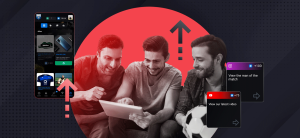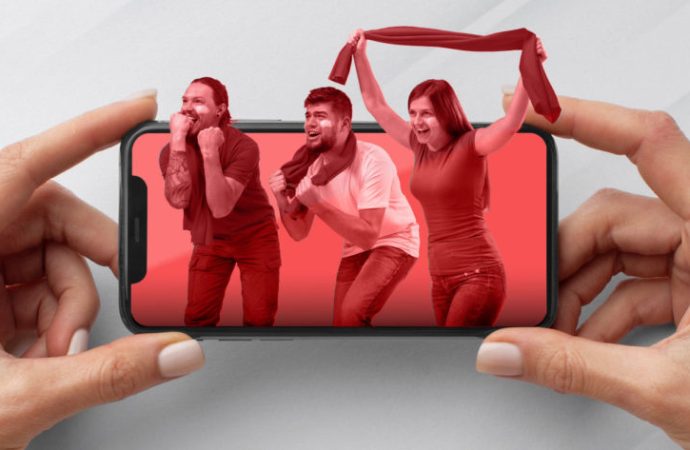Introduction In the last decade, social media has transformed how sports are consumed, shared, and experienced. Platforms like Twitter, Instagram, Facebook, and TikTok have created a new avenue for fans to engage with their favorite teams and athletes. This article explores how social media drives fan engagement in sports, the benefits it brings, and the
Introduction
In the last decade, social media has transformed how sports are consumed, shared, and experienced. Platforms like Twitter, Instagram, Facebook, and TikTok have created a new avenue for fans to engage with their favorite teams and athletes. This article explores how social media drives fan engagement in sports, the benefits it brings, and the challenges teams and leagues face in managing their online presence.
The Rise of Social Media in Sports

Image by: Yandex.com
Social media has grown rapidly in the last decade, becoming a major part of how fans connect with sports. Platforms like Facebook, Twitter, Instagram, and TikTok have millions of users, providing teams a way to reach their audiences directly. This shift has changed how information is shared and how fans experience their favorite sports. Fans can now follow teams, interact with players, and participate in discussions instantly, creating a more engaged community.
Expanding Fan Interaction
Social media platforms provide many ways for fans to interact with their favorite teams. Fans can comment on posts, share their opinions, and ask questions directly to players or team accounts. This interaction creates a two-way conversation that makes fans feel more valued and heard. When teams respond to fans, it strengthens the bond and encourages more engagement.
Building Community
Social media helps create a sense of community among fans. People who share a love for a team or sport can connect online, regardless of where they live. They can form friendships, share experiences, and celebrate victories together. This sense of belonging makes fans more likely to support their teams and participate in events, both online and offline.
Showcasing Diversity and Inclusion
Many sports teams use social media to promote diversity and inclusion. They highlight the stories of athletes from different backgrounds, showing that sports bring people together. Teams share content that celebrates different cultures, identities, and experiences. This approach helps create a more welcoming environment for all fans and promotes positive social change within the sports community.
Driving Merchandise Sales

Image by: Yandex.com
Social media is a powerful tool for driving merchandise sales. Teams often announce new products or sales through their social media accounts. Fans are more likely to buy merchandise when they see it promoted on their favorite platforms. Special promotions, giveaways, and exclusive offers can also encourage fans to make purchases. By effectively using social media, teams can boost their sales and strengthen their brand.
Fan Polls and Surveys
Another way teams engage fans is through polls and surveys. These tools allow fans to share their opinions on various topics, such as favorite players or game strategies. By asking for fan input, teams show that they value their supporters’ voices. This interaction not only boosts engagement but also helps teams understand what their fans want, leading to better content and experiences.
Engaging with Influencers
Sports teams are also working with social media influencers to reach a wider audience. Influencers can help promote games, merchandise, and events to their followers. By partnering with popular figures, teams can attract new fans and engage existing ones. This strategy expands the reach of social media campaigns and builds excitement around the team’s brand.
Benefits of Social Media for Fan Engagement

Image by: Yandex.com
Social media offers many benefits for fan engagement. It allows teams to connect with fans in real-time, share exciting content, and gather feedback. Fans enjoy behind-the-scenes looks at their favorite teams, like training sessions and player interviews. Social media also helps teams promote events, merchandise, and ticket sales. By building strong relationships with fans, teams can create loyal supporters who are more likely to attend games and purchase merchandise.
The Role of Social Media in Sports Marketing

Image by: Yandex.com
Social media plays a vital role in sports marketing. Teams can use these platforms to reach specific audiences and tailor their messages to match fans’ interests. Engaging content, such as polls, contests, and user-generated content, encourages fans to participate actively. Social media influencers can also help teams promote their brand, attracting new fans and enhancing visibility. This marketing approach helps teams stay relevant and exciting in a crowded sports market.
How Social Media Enhances Fan Engagement

Image by: Yandex.com
1. Real-Time Interaction
One of the biggest advantages of social media is the ability to engage with fans in real-time. Fans can comment, like, and share posts instantly, creating a dynamic interaction with teams and players. Live-tweeting during games and posting behind-the-scenes content keeps fans engaged and involved in the action, even if they cannot attend the event in person.
2. Personalized Content
Social media allows teams to tailor content to their audience’s interests. Fans can choose what they want to see, whether it’s highlights, player interviews, or training sessions. This personalized approach increases fan loyalty and keeps audiences returning for more.
3. User-Generated Content
Fans are not just passive consumers; they actively participate in creating content. Teams encourage fans to share their experiences, photos, and videos, amplifying the sense of community. Campaigns like hashtag challenges and contests invite fans to engage creatively, further deepening their connection to the team.
4. Global Reach
Social media breaks geographical barriers, allowing teams to connect with a global audience. Fans from different countries can engage with their favorite teams, fostering a broader community. This global reach opens new markets for teams and creates diverse fan bases.
5. Influencer Collaborations
Many athletes and teams collaborate with social media influencers to reach wider audiences. Influencers can promote events, products, and campaigns, leveraging their followers to enhance fan engagement. This partnership has proven successful in attracting younger audiences who are more active on social media.
Learning from Fan Feedback
Teams can use social media to gather valuable feedback from their fans. Fans can share their thoughts on games, events, and merchandise. This feedback helps teams understand what fans like and what they want to see more of in the future. By listening to their audience, teams can improve their offerings and create a better overall experience for fans. This process of learning and adapting is key to maintaining strong fan engagement.
Connecting with Young Fans
Social media is especially important for connecting with younger fans. Many young people use platforms like TikTok and Instagram, making these spaces ideal for reaching them. Teams can create fun and engaging content that resonates with younger audiences, like challenges and trending videos. By appealing to younger fans, teams can build a new generation of supporters who will follow them for years to come.
Promoting Events and Experiences

Image by: Yandex.com
Social media is an excellent way to promote events and experiences. Teams can share information about games, meet-and-greets, and fan festivals. Posts can include exciting visuals and countdowns to build anticipation. This kind of promotion encourages fans to attend events and participate in activities, which helps strengthen their connection to the team.
Increasing Visibility During Games
During games, social media helps fans stay updated in real time. Teams often post live updates, scores, and highlights. Fans who can’t attend the game can follow along and feel part of the action. This immediacy creates excitement and keeps fans engaged, even from a distance. Teams can also use hashtags to encourage fans to join the conversation and share their thoughts.
Fostering Player-Fan Relationships
Social media allows players to connect with fans on a personal level. Many athletes share their daily lives, training routines, and thoughts on their accounts. This transparency helps fans see players as real people, not just athletes. When fans feel a personal connection to players, they are more likely to support the team. Building these relationships is important for maintaining a loyal fan base.
Engaging with Global Audiences
Social media enables teams to reach fans all around the world. With millions of users from different countries, teams can connect with a global audience. They can share content in different languages and highlight international fans, making everyone feel included. This global reach helps teams expand their brand and grow their fan base beyond local markets.
Challenges in Social Media Fan Engagement

Image by: Yandex.com
Despite its benefits, social media also presents challenges for sports teams. Negative comments and criticism can spread quickly, potentially harming a team’s reputation. Additionally, with so much content available, it can be hard for teams to stand out and keep fans interested. Smaller teams may struggle to maintain an active online presence due to limited resources and staff. Managing these challenges effectively is crucial for maintaining a positive fan experience.
1. Negative Comments and Backlash
While social media provides a platform for fan interaction, it also exposes teams to criticism and negativity. Negative comments can quickly go viral, leading to potential damage to a team’s reputation. Managing this feedback and maintaining a positive online presence is crucial.
2. Content Saturation
With so much content being shared daily, standing out can be challenging. Teams must develop creative strategies to engage fans effectively and avoid content fatigue. This challenge requires constant innovation to keep fans interested and invested.
3. Time and Resource Constraints
Managing a social media presence requires dedicated time and resources. Smaller teams and organizations may struggle to maintain an active online presence due to limited staff and budget. This disparity can lead to uneven engagement levels among different teams and leagues.
The Future of Social Media in Sports

Image by: Yandex.com
The future of social media in sports looks bright. As technology continues to evolve, teams will find new ways to engage fans. Live streaming, virtual reality, and interactive content are just a few possibilities. Social media will likely play an even bigger role in how fans experience sports, making connections stronger than ever. Teams that adapt and embrace these changes will continue to thrive in the ever-evolving world of sports.
Analysis of Social Media’s Impact on Fan Engagement
| Aspect | Description | Impact |
|---|---|---|
| Real-Time Interaction | Fans engage during live events through comments | Increases excitement and immediacy |
| Personalized Content | Tailored content for specific audience interests | Boosts loyalty and retention |
| User-Generated Content | Fans create and share their own content | Fosters community and connection |
| Global Reach | Access to a worldwide audience | Expands fan base and market opportunities |
| Influencer Collaborations | Partnerships with influencers for promotion | Attracts younger demographics |
Comparative Table of Social Media Platforms in Sports Engagement
| Platform | Key Features | Target Audience | Engagement Level |
|---|---|---|---|
| Live updates, instant reactions | Sports enthusiasts | High | |
| Visual storytelling, highlights, stories | Younger audiences | Very High | |
| Community building, event promotions | General sports fans | Moderate | |
| TikTok | Short, engaging videos, viral challenges | Gen Z and younger millennials | Very High |
Conclusion
Social media has become an indispensable tool for driving fan engagement in sports. It offers teams and leagues a platform to interact with fans in real time, share exclusive content, and market their brand effectively. However, the challenges of negative feedback, content saturation, and resource constraints must be managed carefully. As the digital landscape evolves, sports organizations that adapt their strategies will continue to foster strong connections with their fan base, ensuring the vitality and longevity of their brands.
















